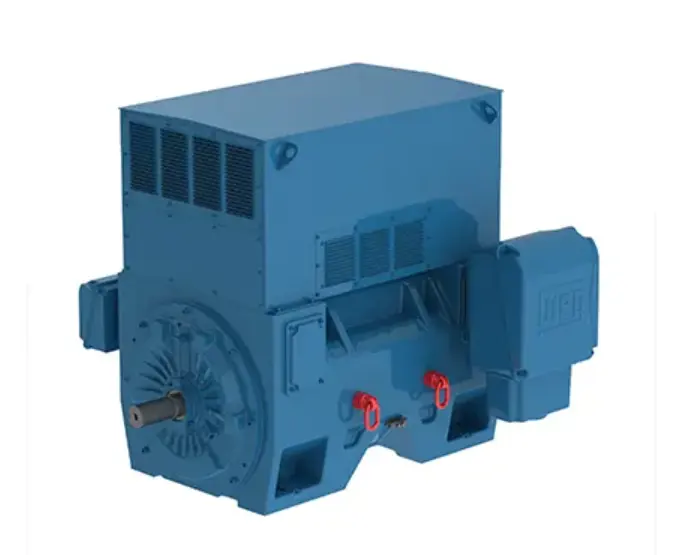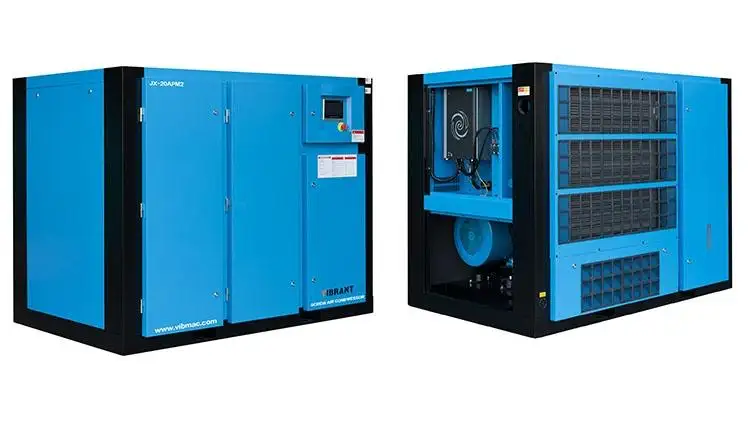
1. Composition of air compression system
The Variable Frequency Air Compressors system on the offshore oil and gas processing platform mainly includes the inlet filter, air compressor, cooler, oil-water separator, drying filter, high-efficiency filter, adsorption dryer, on-site control panel, dew-point analyzer, air storage tank and so on.The traditional air compressor is driven by an industrial frequency motor with a constant power supply frequency of 50Hz and constant speed, power and exhaust volume. Inverter air compressor is driven by frequency inverter motor, which needs to be equipped with frequency inverter and frequency control system. The rotational speed, power and exhaust volume can be automatically adjusted by controlling the frequency of the input power supply, and the parameters such as pressure, flow and temperature can be kept stable.
2. Working characteristics of variable frequency air compressor
2.1 Working principle
Commonly used screw air compressors are basically constant torque loads, where the air supply and power consumption are proportional to the rotational speed. Variable frequency air compressors use pressure transmitters to real-time sense the air pressure in the system pipeline or air storage tank. Through the Variable frequency inversion drive controller, the motor speed is adjusted without altering the motor torque to regulate the exhaust volume in response to changes in downstream pressure and air consumption, ultimately stabilizing at the set pressure value. When the system's air consumption increases, the pressure gradually decreases, and the variable frequency air compressor automatically increases its speed. Conversely, it automatically reduces speed to decrease the compressed air output.
Variable frequency inversion speed control technology realizes constant pressure air supply control for compressed air and instrument air on the platform, as shown in brief control process in Figure 1. By adding frequency conversion switching functionality, the original control and protection systems can be retained. The motor is started by the inverter from a standstill to rotation, enabling soft start of the air compressor.

2.2 Working Characteristics
The set pressure of the variable frequency air compressor can be the minimum pressure required for production, and the compressor’s speed can be adjusted based on the fluctuation trend of the pipeline pressure to eliminate unloaded operation.
Air compressors are generally designed with a capacity or selection that leans towards being oversized, resulting in a low probability of long-term full-load operation. Using variable frequency speed control can increase efficiency.
Continuous adjustments can be made based on load changes to maintain stability in parameters such as pressure and flow rate, thereby improving the working performance of the compressor.
2.3 Advantages of variable frequency air compressor
Energy saving: Variable frequency air compressors operate in an economical state based on demand volume and set pressure. Compared to traditional air compressors, the energy-saving effect is significant, with electricity consumption savings of approximately 30% to 40% per year.
Stable system air pressure: Due to the continuous speed control feature of the variable frequency drive, the compressor starts smoothly and can respond quickly even in situations with large fluctuations in air usage. Compared to the upper and lower limit switch control of fixed speed operation, the stability of air pressure is significantly improved.
Reduced startup impact: Conventional fixed speed startups generally require over six times the rated current, but variable frequency drives have soft starter functions, limiting the startup current to no more than 1.2 times the rated current. This helps avoid the impact of high current startups on the platform's power grid and mechanical systems.
Adjustable exhaust volume: Fixed speed air compressors can only operate at the rated exhaust volume, while variable frequency air compressors have a wider range of exhaust volume adjustments. They can automatically go into sleep mode when the air usage is low. Optimized control can further enhance energy-saving effects.
Better power adaptability: The over-modulation technology used in the variable frequency drive enables it to provide sufficient torque to drive the motor even when the AC power voltage is slightly low. Similarly, slight increases in voltage do not lead to excessively high output voltages. For platforms with self-generated power, variable frequency drives demonstrate their advantages more effectively.
Reliable operation: Variable frequency drive systems are equipped with protection functions against overload, loss of pressure, under-voltage, over-current, phase loss, etc., ensuring stable and reliable operation with reduced failure rates.
Vibration and noise reduction: In most operating conditions controlled by variable frequency drives, the compressor runs at speeds lower than the rated speed, resulting in significantly reduced mechanical vibration and noise levels.
Extends compressor life: The variable frequency drive initiates compressor startup from 0Hz, with adjustable startup acceleration time to reduce the impact on electrical components and mechanical parts during startup, enhancing system reliability and extending the compressor's lifespan. Variable frequency control can decrease current fluctuations' impact on the platform's power grid and power generation equipment, prolonging their service and maintenance lifespan.
3. Application on offshore platforms
3.1 Satisfy the requirements of the energy efficiency assessment
At the feasibility study stage, offshore oil and gas field development projects are required to carry out energy efficiency assessment and form an energy efficiency assessment report. The energy consumption of the proposed project should be controlled at source to ensure that the project, after completion, meets the requirements of relevant national laws, regulations and standards in terms of energy conservation and comprehensive utilization. The Energy Efficiency Assessment Report (EEAR) is a program guidance document with clear requirements for energy efficiency of the equipment that must be met. For the equipment with large load fluctuation and long time operation, it should be selected with frequency conversion capability or adopt frequency conversion control measures.
3.2 Selection of air compressor
Selection of an affordable variable frequency air compressor should first be analyzed and calculated based on factors such as different production conditions and probabilities on the platform, air consumption under each condition, and system stability requirements, then select the model against the manufacturer's standard product. In order to ensure the reliability of the air compressor system, air compressors, dryers and filters should be set up with a back-up unit, usually one or two machines are required and can be switched over periodically or manually.
3.3 Installation forms of variable frequency drives
The installation forms of variable frequency drives for air compressors can be either internal or external. Internal means that the frequency converter and control system are installed in the air compressor, which is a unified responsibility of the air compressor manufacturer. External that is, the frequency converter is installed in the platform of the frequency converter room (referred to as the VFD room), the air compressor manufacturer is only responsible for the provision of air compressors, and to ensure that the drive motor is a frequency converter motor to meet the frequency control.
(1) Analysis of pros and cons of internal installation
The variable frequency system is integrated with the air compressor, offering a complete supply range and a clear interface; it does not occupy space in the platform's VFD room; it saves cable connections from the air compressor to the inverter; however, the weight and size of the integrated air compressor is large and the lead time is relatively long; Inverter cabinets require a separate air conditioning or refrigeration system.
(2) Analysis of pros and cons of external installation
The weight and size of the integrated air compressor is smaller, and the lead time is relatively shorter; the platform needs to be configured with a separate frequency conversion and control system, and the interface is complicated, and it is necessary to increase the room area and air-conditioning cooling capacity in VFD room, there are more cable connections from the air compressor to the VFD.
In conclusion, based on the comprehensive analysis above, internally installed variable frequency air compressors are more suitable for application on offshore platforms.
3.4 Adaptation adjustment of auxiliary systems
(1) Addition of settings to the on-site control panel
Manual and automatic inverter control selection; inverter and industrial frequency switching selection; inverter remote control signal; point-to-point frequency adjustment control; inverter fault alarm; motor speed, running frequency and current display, etc.
(2) Heat dissipation of variable frequency drives
Internally installed variable frequency cabinets need to be equipped with air conditioning or forced cooling devices; externally installed ones require an overall increase in the cooling capacity of the VFD room air conditioning or an increase in the number of air conditioners.
(3) Adjustment of the electrical distribution system
Additional circuit breakers, contactors, miniature circuit breakers, emergency stop buttons, reset buttons, control protection relays, transformers, terminal blocks, cables, etc., should be added as needed.
4. Conclusions
Traditional fixed frequency air compressors operate under conditions of significant load fluctuations for a long time, resulting in high energy consumption. The frequent start-stop cycles have led to noise pollution and mechanical vibrations. Currently, international oil prices remain low, in this situation, the implementation of offshore oil and gas field development projects requires optimization through design solutions and cost reduction measures to improve efficiency.
Compared with the traditional industrial frequency air compressor, the initial investment cost of variable frequency air compressor is relatively high, and the auxiliary system design and configuration requirements are more stringent, but it has the advantages of energy saving, low noise, stability, and high efficiency, which is the development direction of the future application of air compressor system on offshore platform. Inverter air compressor with its obvious advantages will be widely used on offshore oil platforms. Check new blog here.








